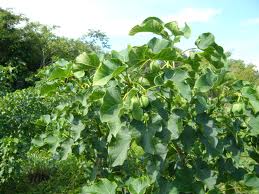| PlantID | 0088 |
| Botanical Name | Jatropha curcas |
| Common Name | Bagbherenda |
| Classification | | Kingdom: | Plantae | | Subkingdom: | Tracheobionta | | Division: | Magnoliophyta | | Class: | Spermatopsida | | Subclass: | Rosidae | | Order: | Malpighiales | | Family: | Euphorbiaceae | | Genus: | Jatropha | | Species: | curcas |
|
| Part used | Leaves, seeds, oil, twigs, stem and root-bark. |
| Medicinal Properties | Seed: oil is depurative and purgative; Leaves: lactagogue and suppurative; Stem: styptic. |
| Medicinal Use | Seed: oil is externally applied in chronic rheumatism and skin diseases, haemorrhoids, wounds, splenomegaly; Leaves: useful in foul ulcers, tumours and scabies; Twigs: used as a tooth brush for swollen gums; Root-bark: locally applied in rheumatism. |
| Chemistry | Seeds: amino acids- arachidic, linoleic, myristic, oleic, palmitic and stearic acids. arabinose, galactose, glucose, rhamnose, xylose, galacturonic acid and beta-sitosterol; stem: beta-D-glucoside of beta-sitosterol; Kernel: dulcitol and sucrose; Leaves: vitexin and isovitexin, campesterol, l-triacontanol. |
| Cultivation | NA |
| Regional Habitat | Commonly found throughout in Rajasthan, in plains and in hedges. |
| Description | A large glabrous shrub, 3-4 m high. Leaves: long-petioled, orbicular-cordate, entire or 3-5 lobed. Flowers: yellow, corolla-tube of male villous within, ovary and styles glabrous. Capsule: 2.5-3 cm long, ellipsoid, faintly lobed, breaking into 2-valved cocci. Seeds: upto 2 cm long, black, ellipsoid-oblong. Flowers and fruits from April-September. |
| Image |  |


